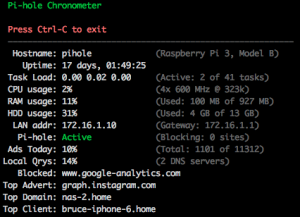Pi-Hole is an amazing DNS based ad blocker. One of its ancillary features is it’s text-based “Chronometer” mode. If you invoke pihole with the “-c” option you will see a display like the following that refreshes automatically:
While this Chronometer is handy it’s still rather lacking in the information it provides. A drop-in replacement called PADD has been available for a while that provides significantly more data about your Pi-Hole’s activity. While PADD is a huge leap over the built-in Chronometer functionality I felt that it was also a little lacking. Many people run Pi-Hole on Raspberry Pi’s (not surprising given its name), and many people who use Chronometer or PADD use a TFT LCD screen, many of which are actually touchscreens.
It occurred to me that a highly customizable text display that leverages the features of LCD touchscreens would be a very powerful tool to complement Pi-Hole. The result of this thought is PHAD, the Pi-Hole Alternate Display. PHAD is a python app that uses the highly popular Jinja2 template engine to make it possible to create custom displays. PHAD also supports cycling between multiple templates by tapping on the Pi-Hole’s touchscreen or on a timed schedule.
For more details on installing and using PHAD see the projects README file over on GitHub.
